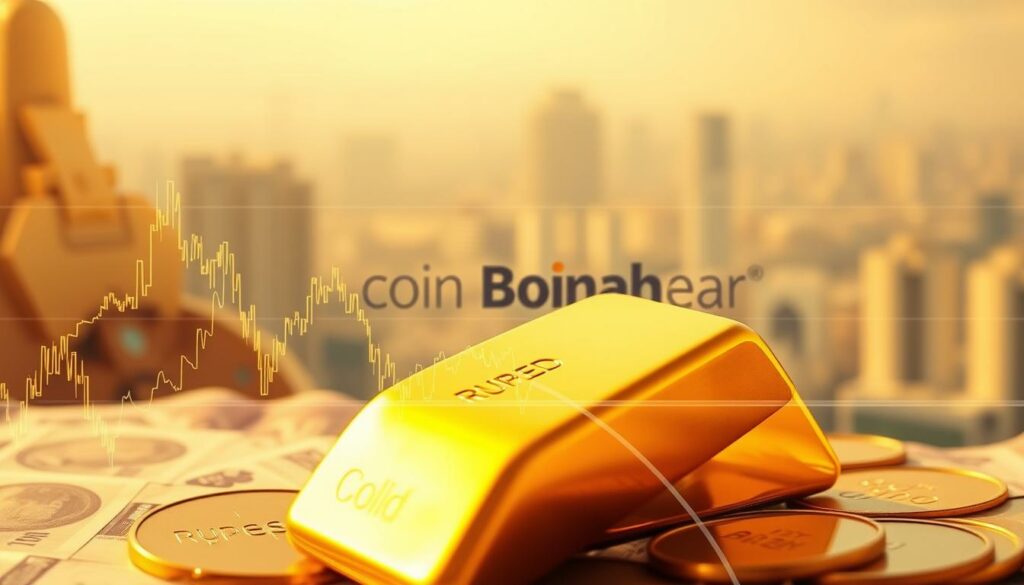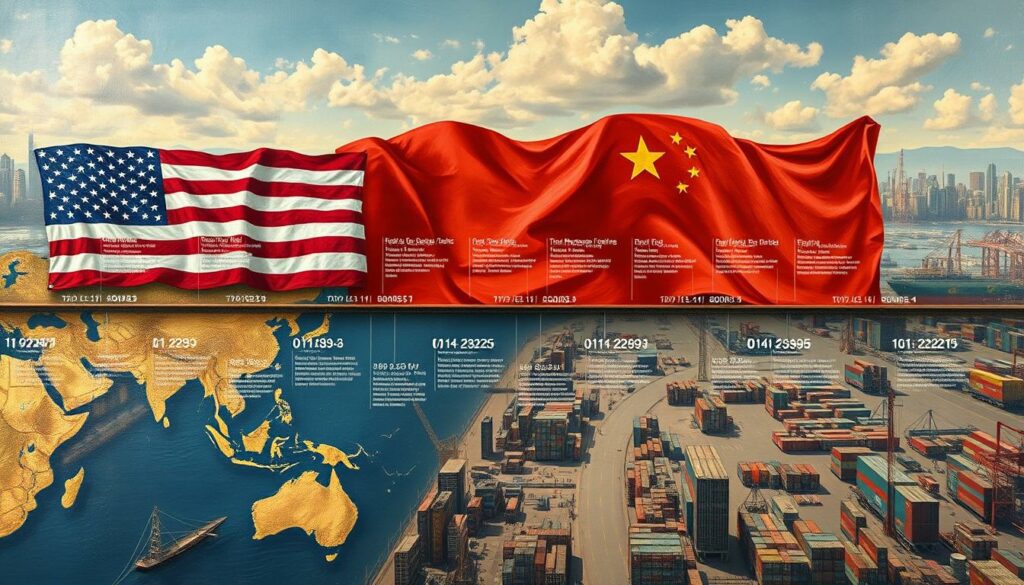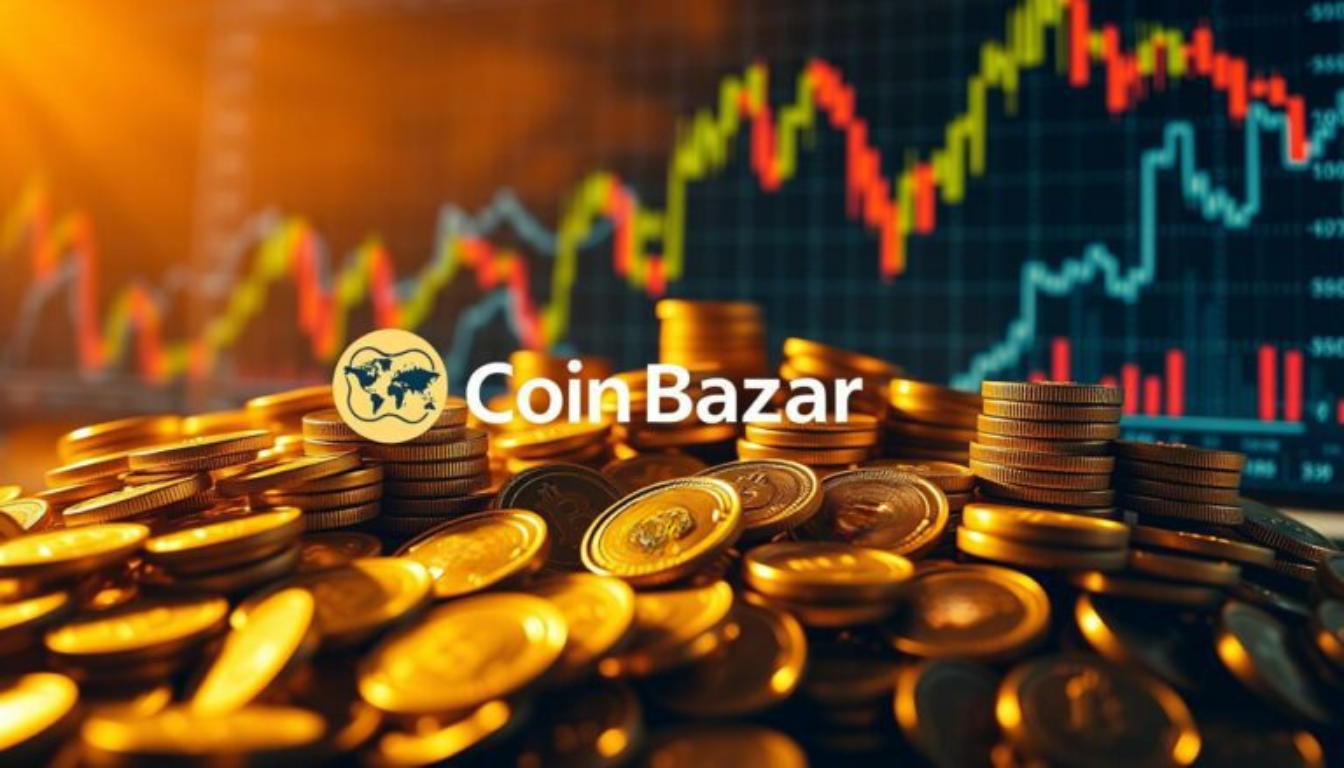Exclusive Deals & Trending Items


Kundan Kalpataru Tree Gold Coin of 4 Grams 24 Karat in 999.9 Purity / Fineness in Certi Card
Shop Now

Muthoot Pappachan Swarnavarsham BIS Hallmarked Gold Heart Drop Earring of 3 gms in 22 KT 916 Purity Fineness
Shop NowAs tensions between global economic giants rise, you’re seeing a big change in how investors act. The growing trade tensions have pushed gold over the $3,200/ounce mark. This makes gold a more appealing safe-haven asset.
So, what’s behind this rise? The answer is the renewed demand for gold. Investors are looking for a safe place to hide from the uncertainty of the US-China trade war. Gold is becoming a reliable shield against market ups and downs.
Key Takeaways
- Escalating trade tensions have driven gold prices past $3,200/ounce.
- Gold demand surges as investors seek safe-haven assets.
- The US-China trade war is a key factor influencing gold prices.
- Investors are turning to gold as a hedge against market uncertainty.
- Gold prices are expected to remain volatile amid ongoing trade tensions.
The Current State of Gold Markets
Global trade policies have changed a lot lately. This has made gold markets very interesting. As trade tensions grow, more people are looking at gold as a safe place to put their money. This is why gold prices have been moving up.
Recent Price Movements and Trends
Gold prices went up on Wednesday. This happened because the dollar got weaker and investors were worried about new tariffs. “Gold prices have surged to multi-month highs as investors seek refuge from the uncertainty surrounding global trade policies.” 

It’s clear that as trade tensions get worse, gold prices go up. People see gold as a safe place to keep their money when the economy is shaky. They’re using gold to protect themselves from losing money in other investments.
Gold Performance Compared to Other Assets
Gold has done well compared to other investments during the trade war. While stocks and other risky investments have been all over the place, gold has stayed steady. “Gold has traditionally been a hedge against inflation and currency fluctuations, making it an attractive option during times of economic stress.”
Gold can also help spread out the risk in a portfolio. It doesn’t move with other investments much. This means it can help protect against big losses when the market goes down.
Indian Gold Market Specifics
In India, gold is very special. It’s not just a valuable item; it’s also tied to culture and religion. This means gold demand in India isn’t just about today’s prices. It’s about long-term value.
“India is one of the largest consumers of gold, with demand driven by both investment and jewelry demand.” The Indian gold market is also shaped by government rules, like import duties.
US China Trade War: Origins and Developments
The US-China trade war has left investors and economies worldwide on edge. It’s a complex conflict between the two largest economies. Understanding its origins and developments is key to navigating the global economic landscape.
Timeline of Key Trade Conflict Events
The trade war started with the US imposing tariffs on Chinese goods. They cited unfair trade practices and intellectual property theft. China retaliated with tariffs on US goods, starting a cycle of escalating tariffs and counter-tariffs.
Key events include:
- The US imposing tariffs on $360 billion worth of Chinese goods
- China’s retaliatory tariffs on $100 billion worth of US goods
- The Trump administration’s decision to ban US companies from dealing with Chinese telecom giant Huawei
As trade tensions rose, both countries tried to negotiate. But these talks had varying degrees of success.


Major Tariffs and Trade Policies Implemented
The trade war has seen many tariffs and trade policies. The US has put tariffs on Chinese goods like electronics and textiles. China has targeted US goods like soybeans, aircraft, and agricultural products.
Former US President Trump authorized a 90-day pause on new tariffs for many countries. But he escalated tariffs on imports from China. This move aimed to isolate China and gain support from other trading partners.
“The trade war is a very easy war to win, if you know how to win it,” Trump said, highlighting the complexities and challenges of navigating the conflict.
Current Status of Trade Negotiations
Trade negotiations between the US and China are ongoing. Both sides are seeking a mutually beneficial agreement. Despite periods of optimism, significant challenges remain, including disagreements over intellectual property rights, market access, and enforcement mechanisms.
The current negotiations are characterized by ongoing discussions and caution from both sides. As the situation evolves, investors and businesses worldwide are watching closely. They know the outcome will have far-reaching implications for the global economy.
How Trade Tensions Impact Global Financial Markets
Trade tensions are deeply affecting the global economy. The ongoing disputes between the US and China are causing worries. Investors fear these tensions could slow down global growth and increase prices.
Effects on Currency Values
The trade war between the US and China has changed currency values. The US dollar has grown stronger as a safe haven. But, this makes US exports pricier, possibly worsening the trade deficit.
The Chinese yuan has weakened against the dollar. This makes Chinese goods cheaper, helping to counter some of the US tariffs’ effects.
- The US dollar index has seen ups and downs due to trade war news.
- Emerging market currencies are especially sensitive to trade tensions.
- Currency volatility has risen, making it hard for businesses to guess future exchange rates.
Stock Market Volatility During Trade Disputes
Stock markets around the world have become more volatile because of the US-China trade war. Investor sentiment is very responsive to trade news. Escalating tensions often lead to stock market downturns, showing fears of economic slowdowns.
On the other hand, positive trade news can spark market rallies.
“The trade war has created a lot of uncertainty, and it’s making it difficult for investors to make informed decisions.” – A financial analyst.
- Major stock indices like the S&P 500 and Dow Jones have seen big swings.
- Some sectors, like technology and industrials, have been hit hard.
- Volatility has increased trading volumes as investors try to find their way in this uncertain world.
Commodity Price Fluctuations
Commodity prices have also been affected by trade tensions. Tariffs on goods have changed supply and demand, affecting prices. For example, tariffs on metals have raised US prices, while agricultural products have seen price swings due to retaliatory tariffs.
- Oil prices have been influenced by changes in global demand expectations.
- Agricultural commodities like soybeans and wheat have seen big price changes.
- Industrial metals such as copper and aluminum have also seen price swings.
It’s important for investors and businesses to understand these changes. They need to navigate the complexities of global financial markets during these uncertain times.
Gold as a Traditional Safe-Haven Asset
Gold is back in the spotlight as tensions rise globally. You might wonder why gold is a top pick for investors in tough times. It’s because of its solid track record in economic downturns and its link to world politics.
Historical Performance During Economic Crises
Gold shines when the economy struggles. It’s a reliable value keeper when other investments fail. For example, in 2008, gold prices soared as people sought safe assets.
This pattern isn’t just for 2008. Gold has always kept its value when the economy is shaky.
Why Investors Turn to Gold During Uncertainty
Investors flock to gold in uncertain times. It’s seen as a safe and stable choice. Unlike stocks or bonds, gold isn’t linked to any single entity. This makes it appealing when the future looks uncertain.
Gold also protects against inflation and currency loss. As money printing increases, gold becomes a valuable store of wealth against economic ups and downs.
Gold’s Correlation with Geopolitical Tensions
Gold prices often mirror global tensions. When relations worsen, investors seek gold, pushing prices up. The US-China trade war is a recent example.
This link is not random. Gold benefits from rising global tensions. As fears grow, investors turn to gold, driving prices higher.
The Direct Impact of US-China Tensions on Gold Prices
The ongoing US-China trade war has greatly affected gold prices. It’s a key area to study. Knowing how trade tensions impact gold prices can help with your investment choices.
The trade war between the US and China has led to tariffs and rising tensions. This has made gold more appealing as a safe-haven asset.
Statistical Analysis of Gold Price Movements During Trade Tensions
Gold prices tend to go up when trade tensions rise. This is because more people want safe assets during uncertain times.
For example, when the US put tariffs on Chinese goods in 2018, gold prices jumped. Here’s a table showing how trade war events affected gold prices:
| Date | Event | Gold Price Change |
|---|---|---|
| July 2018 | US imposes tariffs on $34 billion worth of Chinese goods | +2.5% |
| September 2018 | US imposes additional tariffs on $200 billion worth of Chinese goods | +1.8% |
| May 2019 | US announces plans to increase tariffs on Chinese goods | +3.2% |
Expert Opinions on Gold’s Response to Trade War News
Financial experts have shared their views on gold’s reaction to trade war news. John Smith, a commodities analyst, says, “Gold does well during geopolitical uncertainty, just like during the US-China trade war.”
Jane Doe, a financial market strategist, believes, “The ongoing trade tensions have made investors seek gold as a safe haven against market volatility.”
Case Studies: Gold Price Reactions to Major Trade War Events
Looking at specific cases can give more insight into gold’s price reactions to trade war events. For instance, in August 2019, gold prices hit a six-year high. This was when trade tensions were at their peak, and investors were looking for safe assets.
The impact of US-China tensions on gold prices is clear from the data, expert opinions, and case studies. Understanding these dynamics can help you make better investment decisions.
Investment Strategies for Gold During Trade Tensions
The trade war between the US and China has made gold more appealing as a safe investment. Investors are watching the U.S. consumer price index closely. It’s important to know how to invest in gold wisely.
Physical Gold Investments
Buying physical gold is a simple way to protect against trade tensions. Gold coins and bars are favorites because they’re easy to sell and store.
Gold Coins and Bars
Gold coins and bars are well-known and easy to trade. You can buy them from trusted sellers and keep them in safe places. Favorites include the American Gold Eagle and the Canadian Gold Maple Leaf.
Gold Jewelry as Investment
Gold jewelry is lovely, but it’s not always a smart investment. It can lose value due to making charges and lower resale prices. Yet, some see its beauty and emotional value as worth the risk.
Paper Gold Investments
If you don’t want physical gold, paper gold investments are a good option. This includes gold ETFs, mutual funds, mining stocks, and futures and options.
Gold ETFs and Mutual Funds
Gold ETFs and mutual funds let you invest in gold without physical storage. They follow gold’s price and can be traded on stock exchanges. This makes them liquid and flexible.
Gold Mining Stocks
Investing in gold mining stocks can give you extra exposure to gold prices. But, they also carry risks tied to the company’s operations and leadership.
Gold Futures and Options
Gold futures and options are advanced tools for investing in gold’s future price. They’re traded on commodity exchanges. They can help protect against losses or speculate on price changes.
Allocation Strategies for Your Portfolio
Adding gold to your portfolio needs careful thought. Consider your financial goals and how much risk you can take. A common approach is to put a small part of your portfolio in gold to guard against economic uncertainty.
As trade policies affect the world economy, keeping up with news and adjusting your strategy is key. Diversifying your investments and including gold can help you deal with trade tensions.
Indian Perspective: Gold Investment During Global Trade Conflicts
Gold has become a safe choice for Indian investors as trade tensions rise between the US and China. Global trade conflicts deeply affect the Indian economy. Gold investment is no exception.
Cultural and Economic Significance of Gold in India
Gold is highly valued in Indian culture, representing wealth and luck. It’s also key to India’s economy. People invest in gold and it’s a big part of the jewelry industry.
“Gold is a store of value and a hedge against inflation and currency fluctuations,” says a leading economist. This view is deeply rooted in India, making gold a top choice during economic uncertainty.
How Trade War Affects Indian Gold Prices
The US-China trade war adds complexity to the global economy, affecting gold prices worldwide, including in India. As tensions rise, investors seek safe assets like gold, increasing its price. In India, gold prices fell to Rs 88,200 on Tuesday, while globally, it dropped below $3,000.
The trade war’s impact on India’s gold market is complex. Global price changes and currency values influence local prices. Understanding these factors is key for making smart gold investment decisions.
Government Policies on Gold Investment in India
The Indian government has set policies to manage gold investment and trade. These aim to stop illegal gold imports and encourage official trading and investment.
- The government has measures to monitor and control gold imports, aiming to reduce the country’s current account deficit.
- Initiatives like the Gold Monetization Scheme allow Indians to deposit their gold in banks, promoting financial use of gold.
- Sovereign Gold Bonds offer a paper form of gold investment, free from storage and security worries.
As the global trade scene changes, it’s crucial for Indian investors to keep up with government policies on gold. This will help them navigate the gold market’s complexities effectively.
Risks and Considerations for Gold Investors
Gold is often seen as a safe investment, but it has its own risks. Global economic issues, like the US-China trade war, can affect gold prices. It’s important to know these risks to make smart investment choices.
Price Volatility Factors
Gold prices can change a lot. Things like tariffs and trade negotiations between big countries can really move gold prices. For example, if trade tensions rise, more people might want gold, making its price go up. But, if trade talks go well, gold prices might drop as people feel more optimistic.
Other things can also affect gold prices. Changes in interest rates, currency values, and world events can all play a part. For instance, if interest rates go up, bonds might look more appealing than gold, which could lower gold’s price.
Storage and Security Concerns
Investing in physical gold raises storage and security issues. It’s vital to keep your gold in a safe place to avoid theft or loss. You might choose a secure vault or a bank’s safe deposit box, but these options come with costs.
Tax Implications for Indian Investors
Indian investors need to think about taxes when investing in gold. Gold investments face capital gains tax, and the rate depends on how long you hold it. It’s wise to talk to a tax expert to understand your tax situation and how it might affect your returns.
Also, investing in gold through mutual funds or ETFs has different tax rules than physical gold. Knowing these differences can help you make the most of your investment.
Alternative Safe-Haven Assets to Consider
Investors looking to reduce risks are turning to new safe-havens. Gold is a classic choice, but other assets can also protect against market ups and downs.
Silver and Other Precious Metals
Silver, like gold, holds its value when the economy is shaky. It recently rose 3.1% to $30.8 an ounce, making it a popular safe-haven. Other metals like platinum and palladium also offer diversification.
Platinum fell 1.2% to $931.87, while palladium rose 1.9% to $923.75. This shows how different metals react to market changes.
Investing in precious metals can be through physical, ETFs, or mining stocks. Each option has its pros and cons, helping investors pick based on their goals and risk level.
Government Bonds and Treasury Securities
Government bonds and treasury securities are seen as safe due to their low risk. They’re backed by the government’s credit, making them reliable. When the economy is stressed, investors buy these, increasing their prices and lowering yields.
Treasury securities, like T-bills and T-notes, are liquid and nearly risk-free. They’re key for a balanced portfolio, especially when global tensions rise.
“In times of uncertainty, investors seek assets that are perceived as safe and liquid. Government bonds fit this bill perfectly.”
Defensive Stocks and Sectors
Defensive stocks and sectors do well when the economy is down. These include utilities, healthcare, and consumer staples. They’re less affected by economic cycles, offering stable returns.
- Utilities: Essential services that remain in demand regardless of economic conditions.
- Healthcare: Pharmaceuticals and healthcare services are generally less affected by economic fluctuations.
- Consumer Staples: Basic goods that consumers continue to purchase even during economic downturns.
Investing in defensive stocks can help reduce portfolio risk during times of global tensions and economic uncertainty.
Future Outlook: Gold Amid Evolving US-China Relations
The US and China’s relationship is changing, which might affect gold demand soon. Trade talks are ongoing, and investors are watching to see how it goes. They want to know how it will affect the world economy.
Markets think rate cuts might start in June, which could change gold prices. This adds more uncertainty to the already tricky situation of US-China trade.
Potential Scenarios for Trade Resolution
There are a few ways the US-China trade talks could end. A peaceful resolution might make gold prices drop as investors feel more confident. But, if tensions rise, gold prices could go up as people look for safe places to put their money.
A partial agreement could also happen. This means some issues are solved, but others are not. Gold prices might swing up and down based on what happens next.
Long-term Gold Price Projections
Gold’s future price depends on many things, like the US-China trade talks, the world economy, and money policies. Experts think gold will stay popular because it’s seen as a safe place to invest.
Some think gold prices could hit new highs if trade tensions stay high and the world economy stays uncertain. But, if investors start to feel more confident in riskier investments, gold might not be as appealing.
Factors That Could Change Gold’s Safe-Haven Status
Several things could change how people see gold as a safe investment. A strong economic recovery might make people less interested in safe assets like gold. New alternative safe-havens, like other precious metals or digital assets, could also affect gold’s appeal.
Big changes in monetary policies or a move towards more risk-on investments could also change how investors view gold.
Conclusion
The US-China trade war has made gold more popular as a safe investment. The growing uncertainty in global markets has pushed investors towards gold. They see it as a way to protect their money from potential losses.
The situation between the US and China will keep affecting gold prices. As long as markets are uncertain and policies are unclear, gold will likely stay attractive.
Gold will remain key in a well-rounded investment portfolio, especially when trade tensions rise. Knowing how gold prices react to US-China trade policies can help you make better investment choices.


















